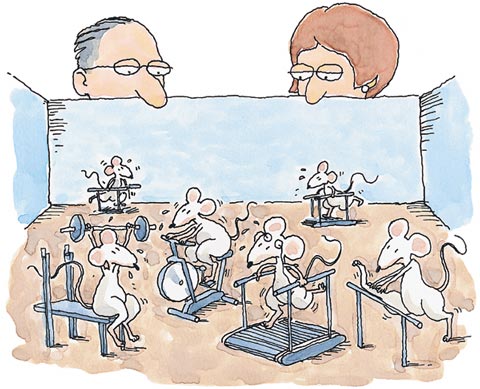Not-So-Mighty Mice
By William Cannon
Enlisting rodents to reduce heart attacks among human athletes
Enlisting rodents to reduce heart attacks among human athletes

DOI: 10.1511/1999.16.0
At the U.S. Olympic Training Center in Colorado Springs, promising elite athletes train effectively. Up the road at the University of Colorado at Boulder, compromised petite athletes train defectively.
The tiny Boulder jocks are transgenic mice. Inserted into their chromosomes are mutant genes that lead to familial hypertrophic cardiomyopathy, or FHC, the primary cause of sudden death of high school football players, basketball stars and scores of other young athletes.
Inside the $1.5 million Center for Mammalian Biology, the mice pound away on itty-bitty treadmills under the watch of a team led by Leslie Leinwand, chair of the university's Department of Molecular, Cellular and Developmental Biology.
The exercise regimen, intended to measure the at-risk heart's response to vigorous activity, is the latest in a series of studies that Leinwand and her colleagues believe will unravel the complex biology that leads to FHC deaths. They hope to devise an easy way to screen for the hard-to-diagnose condition and to work with pharmaceutical companies to find drugs that preempt the genetic damage.
At least seven different genes have been linked to the disease. FHC causes a thickening of the heart muscle that cuts down blood flow in the ventricles and hinders the muscles' ability to pump blood into the arteries. FHC symptoms are vague. They include dizziness, chest pain and shortness of breath. Often the first and only symptom is death—particularly when the heart is working hard and under stress.
Further complicating matters, people with FHC often—but by no means always—have larger-than-normal hearts. The reason for those heart-size differences is a persistent mystery. Plus, the hearts of healthy athletes, like the rest of their muscles, are generally larger than those of people who eschew regular and rigorous exercise. All these variables make the condition particularly difficult to detect.

Tom Dunne
Leinwand's group has fashioned three varieties of mice with FHC mutations, including one linked to the most frequent cause of playing-field death: a defect in a tiny portion of a single gene, one that codes for the protein myosin. Myosin is a main ingredient of muscle, crucial for maintenance of a heart's structural integrity. It also acts as a molecular motor, producing the energy and motion that allow the heart to contract. In people and in mice, healthy heart cells are densely packed with protein in an orderly configuration that enables muscle tissue to contract. In FHC hearts that carry the myosin mutation, cells that should be in a tidy parallel alignment are in disarray and lose function.
The other two mouse varieties carry different mutations of another gene that codes for a regulatory protein called troponin T. The protein is present in a normal heart's tiny muscle fibrils and is involved in calcium's triggering of contractions. Troponin T accounts for little or no heart enlargement in FHC patients. But even a little of the protein produced by mutant genes may be too much.
"In troponin-mutant mice, we can manipulate how much of the protein they make," Leinwand says. "We have found that when the gene makes even a small amount of the protein, it can cause death within eight hours."
The work is starting to pay off. In the past year, Leinwand's group has described the genetics and assembly properties of myosin in the heart and has identified promising molecular markers for FHC.
Leinwand and her collaborators, who hold a patent on their myosin-defective transgenic mice, now have turned pro. They have founded a company, Myogen, to look for a way to improve the motor activity in heart muscles of people with FHC.—William J. Cannon
Click "American Scientist" to access home page
American Scientist Comments and Discussion
To discuss our articles or comment on them, please share them and tag American Scientist on social media platforms. Here are links to our profiles on Twitter, Facebook, and LinkedIn.
If we re-share your post, we will moderate comments/discussion following our comments policy.